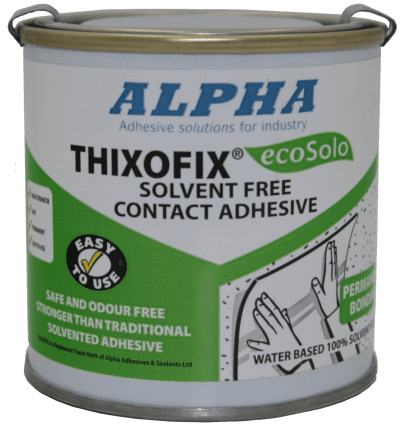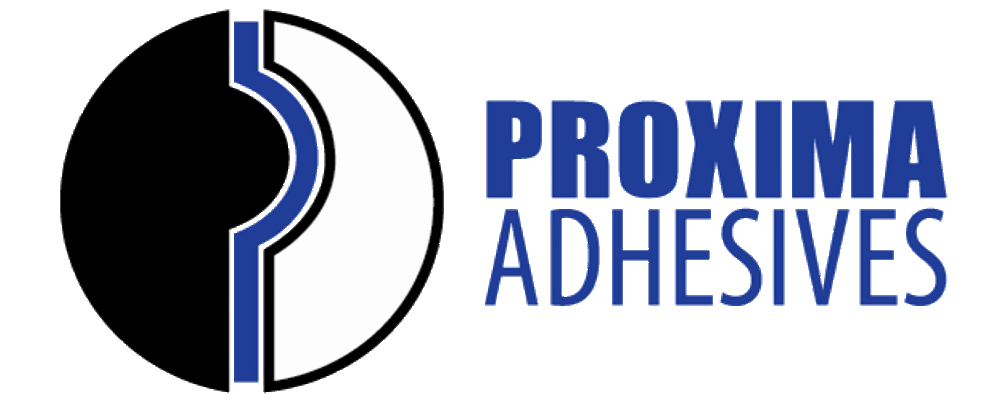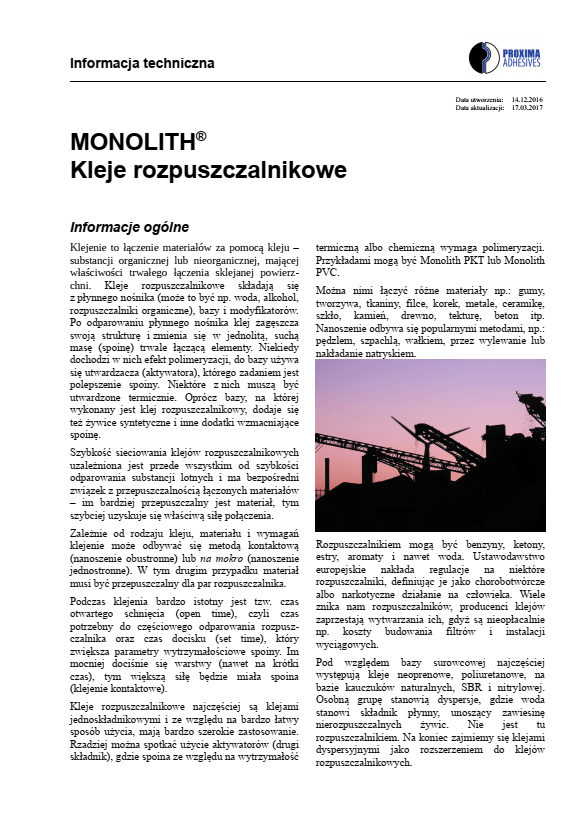Industrial Adhesives
Solvent Adhesives
Solvent adhesives, also known as organic adhesives, are a type of adhesive that contains substances that are soluble in organic solvents. They are widely used in a variety of industries due to their specific properties and applicability to different materials.
Solvent-based adhesives are easy to use because they are in liquid form, which makes them easy to apply to the surfaces to be bonded. Once the adhesive is applied, the solvent evaporates quickly, leaving the bonded materials in a durable and strong condition.
Bonding is the joining of materials by means of an adhesive – an organic or inorganic substance that has the property of permanently joining materials. Solvent-based adhesives consist of a liquid carrier (e.g. water, alcohol, organic solvents), a base and modifiers. After evaporation of the liquid carrier, the adhesive thickens its structure and turns into a homogeneous dry mass (joint) that permanently bonds components.
Sometimes there is a polymerisation effect in them, a hardener (activator) is used in the base to improve the bond. Some require thermal curing. In addition to the base on which the solvent adhesive is made, synthetic resins and other additives are added to strengthen the bond.
One of the advantages of solvent adhesives is that they can also create flexible joints that have good resistance to vibration and changing weather conditions. In addition, solvent-based adhesives can have fast cure times, which speeds up the manufacturing process.
However, it is important to remember that solvent adhesives contain volatile substances that can be hazardous to health and the environment. Therefore, care should be taken when using them and appropriate safety precautions should be followed.
They can be used to bond a wide variety of materials such as rubber, plastics, textiles, felts, cork, metals, ceramics, glass, stone, wood, cardboard, concrete, etc. Application is by common methods such as: brush, spatula, roller, pouring or spraying.
Solvents can be gasoline, ketones, esters, aromatics and even water. European legislation imposes regulations on some solvents, defining them as having either pathogenic or narcotic effects on humans. Many solvents are disappearing as glue manufacturers stop using them because they are uneconomical, e.g. the cost of building filters and extraction systems.
In terms of raw material base, the most common are
- Neoprene or chloroprene (CR) adhesives;
- Polyurethane solvent adhesives;
- Natural rubber based adhesives;
- SBR (styrene-butadiene rubber) based adhesives;
- Nitrile or NBR (nitrile-butadiene-rubber) based adhesives.
A separate group are the dispersions, where water is the liquid component that floats the suspension of insoluble resins.
Information leaflet (in Polish):
Solvent adhesives are effective in bonding a variety of materials such as wood, metal, plastics, leather, textiles and many others. Solvent adhesives are used in the furniture, footwear, wood, leather, packaging and many other industries.
Solvent-based adhesives can bond a wide variety of materials, including
- Rubbers
- Plastics
- Textiles, felts
- Cork
- Metals
- Ceramics
- Glass
- Stone
- Wood
- Cardboard
- Concrete, etc.
The application is done by common methods such as
- Brush
- Spatula
- Roller
- By pouring or spraying.

| Item | Colour | Viscosity [mPa·s] | Density [g/cm3] | Solid content % | Thermal resistance [°C] | Open time Min.[min] Max[min] | Efficiency [ m2/l ] | Appication technique | |
|---|---|---|---|---|---|---|---|---|---|
| CR-based adhesives – Neoprene | |||||||||
| PKT | black, two−component | 2500 ± 250 | 0,87 | 24 ± 1,5% | <120 | 5 / 20 | 2-3 | brush roller | |
| Application: Shelf life: 4 hours, cure time: 2-5 hours. Resistance to: Saltwater, atmospheric oxidation, oils, certain chemicals, aviation fuels, dilute acids and alkalis. Used in: Bonding of conveyor belts, production of flexible water and fuel tanks, bonding of steel tanks with chemically resistant rubber linings, bonding of rubber linings to drive drums, bonding of rubber seals to ship hatch covers, bonding of linings made of hard felt, plastics, laminates (unilam), etc. | |||||||||
| S 5001 | off-white, two-component | 2700 – 3300 | 0,85 | 23 ± 2% | <120 | 5 / 30 | 3-4 | brush roller | |
| Application: Shelf life: 4 hours, cure time: 2-5 hours. Resistance to media: Saltwater, atmospheric oxidation, oils, certain chemicals, aviation fuels, dilute acids and alkalis. Used in: Construction of inflatable rafts, boats and rescue pontoons, manufacture of life jackets, bonding of waterproof fabrics to various substrates, bonding of wet suits, manufacture of flexible water and fuel tanks, bonding of rubber seals to ship hatches. | |||||||||
| S 1922(TF) | yellow red | 120 – 280 | 0,818 | 18 ± 1,5% | -40 – 140 | 2 / 40 | 5-9 | spray | |
| Application: Toluene-free, high temperature adhesive. Used in the automotive, construction and furniture industries. | |||||||||
| Thixofix (S1470) | Honey shade | thixotropic | – | – | <70 | 10 / 15 | 2,5-3 | putty | |
| Application: This is a very versatile adhesive that will bond: wood, rubber, cork, rigid PVC, leather, fabric, chipboard, plaster, gypsum board, fibreboard, painted and unpainted metals and more. | |||||||||
| S 1358 | amber | 5500 – 6500 | 0,88 | 28 ± 2% | <100 | 7 / 20 | 3-4 | brush roller | |
| Application: High temperature contact adhesive. Bonds rubber, rigid PVC, polyurethane foams (polyester or polyether type), leather, non-woven polyester, textiles, painted and unpainted metals. Used in the automotive industry. | |||||||||
| S 708 | golden brown | 4100 – 4600 | 0,87 | 25 ± 1,5% | <70 | 2 / 30 | 3-4 | brush roller | |
| Application: Multi-purpose adhesive used in the manufacture of car and bus interiors, shops and bars, footwear, furniture, boatbuilding and many other industrial applications. | |||||||||
| Polyurethane Solvent Adhesives | |||||||||
| PVC | amber two component | 2800 ± 400 | 0,86 | 23 ± 1,5% | <60 / <120 | 5 / 20 | 2-3 | brush roller | |
| Application: Shelf life: 8 hours, Cure time: 48 hours. Formulated as a product for bonding PVC and PU fabrics (e.g. in conveyor belts) and for glass fibre reinforced composites (GRP) used in the manufacture of rigid hulls for inflatable boats, the construction of inflatable rafts or the manufacture of divers’ costumes. | |||||||||
| S 1762MB | clear | 100 – 150 | 0,85 | 10 ± 0,5% | – | 0 / 5 | 13 | spray | |
| Application: Used for bonding plasticized PVC, also with other materials where there is a problem of plasticizer migration, as a primer. Resistant to oil, detergents and moisture. | |||||||||
| Natural rubber based adhesives | |||||||||
| S 889 | off-white | 54000-60000 | 0,814 | 45 ± 3% | <60 | 5 / 10 | 1,5 – 2,5 | brush roller | |
| Application: Multi-purpose adhesive. For permanent bonding of various materials such as natural and synthetic rubbers (including those with high styrene content), PVC coated felt, upholstery fabrics and fibreglass fabrics to metal, wood, plywood. In the automotive industry it is suitable for bonding carpets and upholstery. In the construction industry, this adhesive can be used for rigid polystyrene/styropor and can also be used to cover wall and ceiling surfaces as an insulating material. | |||||||||
| SBR (styrene-butadiene rubber) based adhesives | |||||||||
| SN 1634 Trimspray | yellow | – | – | 19 ± 1,5% | <70 | 0,5 / 30 | 6 (from a single sprayer) | spray | |
| Application: Aerosol with many applications, especially in the automotive sector. It can be used to bond the following materials: foam, textiles, carpets, leather, wood, cardboard, insulation materials. Typical applications include bonding linings, upholstery, latex and plastic foams, jute, carpets and leather to each other or to metals, wood or fibreboard. Also bonds other fabrics, insulation, fibreboard and paper. Good UV resistance. | |||||||||
| S 1899 | red or clear | 550 ± 100 | 1,133 | 28 ± 2% | <60 | 0 / 30 | 9-11 | spray | |
| Application: Non-flammable, spray type. Can be used to bond flexible foams, cotton fabrics, glass fibres, wood and paper, as well as materials such as painted or unpainted metals, fibreboard, rigid polyurethane foams. | |||||||||
| NBR (Nitrile Butadiene Rubber) based adhesives | |||||||||
| S 1588 | clear | 4500 – 5500 | 0,85 | 25 ± 1,5% | <60 | 1 / 10 | 1,5 – 2,5 | brush roller | |
| Application: For permanent bonding of soft PVC with the addition of plasticiser, but also for bonding polyurethane foams to each other or to metal. Can be used as a general purpose adhesive for bonding wood, felt and many other materials. The bond is highly resistant to oil and grease. | |||||||||
| Adhesives based on synthetic resin dispersions | |||||||||
| VD 6611−1 | milky white, clear | 2000 – 3000 | 1,0 | 67 ± 1,5 % | <80 | – | 0,02 – 0,3 | spray roller | |
| Application: Used for coating paper (e.g. labels), fabrics and plastic films (e.g. soft PVC, rigid PVC, polyester and polyethylene), for applying films to chipboard and in sandwich materials for bonding polyester glass laminates to polyurethane foam. It is also very suitable for bonding polystyrene layers. | |||||||||
| VD 6612−1 | milky white, clear | 1200 ± 400 | – | 69 ± 1 % | <80 | – | – | spray roller | |
| Application: Used for the adhesive coating of paper (permanent stickers), fabrics and plastic films (e.g. soft PVC, rigid PVC, polyester and polyethylene). Due to the large number of film types on the market, preliminary tests should be carried out. Also used for applying films to chipboard and in sandwich materials for bonding polyester glass laminates to polyurethane foam. | |||||||||
Solvent adhesives consist of a liquid carrier (this can be e.g. water, alcohol, organic solvents), a base and modifiers. After evaporation of the liquid carrier, the adhesive thickens its structure and turns into a homogeneous dry mass (joint) that permanently bonds the components.
Information leaflet (in Polish):
More about solvent adhesives in the
You can also read about large area bonding with polyurethane adhesives.


